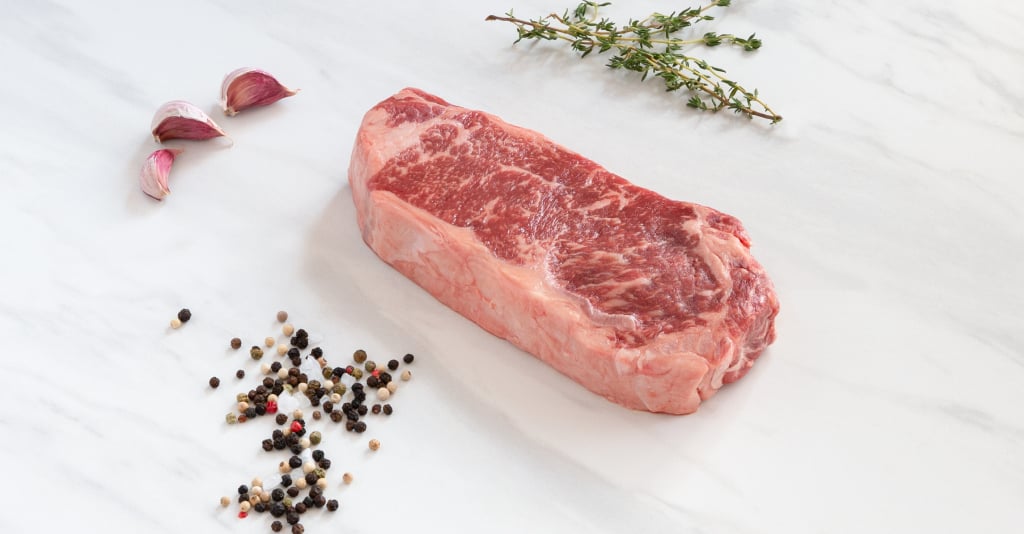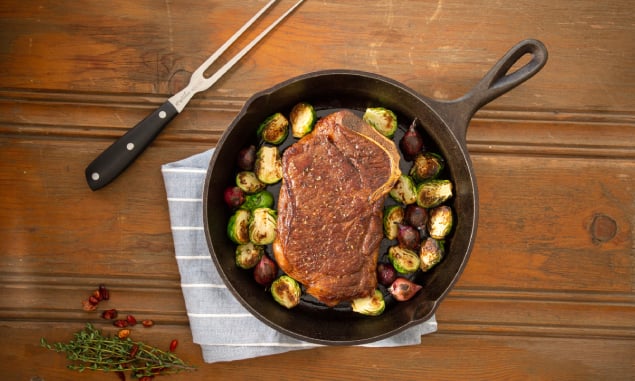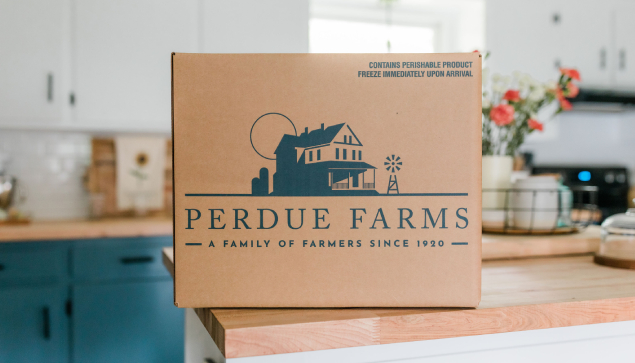
HOW TO DEFROST BEEF
Your Perdue Farms order will arrive at your door, expertly packed and frozen at the peak of freshness. What’s the best way to defrost your steaks, ground beef and roasts — and do you dare cook beef from its frozen state? Here, our culinary team shares tips and tricks that will help you make the most of your premium beef.*
We believe that the best way to thaw steak is by placing products – still in their original packaging – on a plate or tray with a lip to catch any juices, place the tray in the refrigerator on the lowest shelf to avoid any potential cross contamination and let thaw overnight. As a rule of thumb, a 1-inch steak will take between 12 and 24 hours to completely defrost.
Note: Our bone-in steaks feature a bone guard pad that protects steaks during shipment. Pads should be removed after beef has thawed and before cooking.
For best results, we suggest that you let steak rest at room temperature before cooking. For more details, refer to our Steak Cooking Guide.
Can You Defrost Steak on the Counter?Thin cuts of steak can defrost on the countertop, but as a rule do not thaw any cut of beef at room temperature that takes more than four hours to defrost.
Your steak will come vacuum sealed, so running steak under cold water is the preferred (and fastest) method of defrosting at room temperature. The cool water will keep the exterior under 70 F as the center of the cut thaws.
Defrosting Steak in the Microwave: A Good Idea?Although this is the fastest method of thawing out a frozen steak, it will result in a dry product, once cooked. We do not recommend microwave defrosting for the premium cuts of steaks we offer at Perdue Farms.
Sous Vide Frozen SteakAn alternative to microwave defrosting that’s worth a try: Cooking frozen steak in an immersion bath. To do so, remove the product from packaging and season with sea salt and black pepper. Add steak, along with a garlic clove and a sprig of thyme, to a vacuum food sealer bag. Use pump to seal. Set temperature of the water bath to 125 to 130 F. Place bag in water for one hour. Remove bag from water, then remove steak from bag and place onto a try. Pat steak dry. Heat a medium-sized skillet over medium heat; add a splash of olive oil. Place steak in the pan. Sear on both sides until brown. Check internal temperature with a digital meat thermometer. Remove from pan when steak reaches desired doneness.
Steak Doneness Temperatures- Solid rare: 130 F
- Mid-rare: 132 to 135 F
- Light medium: 138 to 142 F
- Medium well: 145 to 150 F
- Well: 160 F or higher
Our steaks can be stored for six to 12 months in the freezer.
How Long Can Thawed Steak Stay in the Fridge?If your Perdue Farms steak remains in its original packaging after being defrosted, steak can be stored for three to five days in the refrigerator.
Can You Defrost Steak and Then Refreeze It?If steak hasn’t been left out at room temperature for an extended period of time, it is perfectly safe to do so. However, refreezing will damage the muscle fibers and result in a dryer product, once defrosted again and cooked.
Can You Cook Steak From Frozen?If steak has thawed completely on the outside but is still slightly frozen in the center, cook as normal. The center will thaw while the meat is cooking.
We do not recommend cooking completely frozen cuts of steak from Niman Ranch and Panorama Organic . You’ve invested in premium beef and should handle products as such.
In case of a cooking emergency, follow these instructions:
Option 1: Sear steak on the flattest frozen side, then place steak in a 250 F oven. Cook slowly until the internal temperature of steak, when measured with a digital meat thermometer, reaches desired doneness.
Option 2: Place frozen steak in a 250 F oven and cook until the internal temperature, when measured with a digital meat thermometer, reaches 100 F. Remove steak from the oven, season with salt and pepper and place in a hot cast-iron skillet; reverse sear. Once seared, place steak back in the oven and cook to desired doneness. (See our steak cooking guide for steak doneness temperatures and searing instructions).
The best way to defrost ground beef is the refrigerator method listed above. Place vaccum-sealed pouches on a tray with a lip, place the tray in the lowest shelf of the refrigerator and let thaw overnight.
Microwaving is the fastest way to defrost burgers and ground beef. To do so, place product on a microwave-safe plate and use a low setting to thaw. Check product frequently during the cycle. Don’t thaw product completely. Product is ready to cook when the outside is completely defrosted.
Frozen ground beef can also be thawed in water. Before submerging, ensure that packaging contains no rips or tears. Water should be cold, below 70 F. Change water every 30 to 45 minutes. Product will take one hour per pound of beef to defrost.
Note: Be sure to read the cooking instructions on beef burgers; Niman Ranch burgers are designed to be cooked from frozen. See cooking-from-frozen ideas below.
How Long Can Defrosted Ground Meat Stay in the Fridge?You can store defrosted ground beef in the refrigerator for one to three days.
Can You Refreeze Defrosted Ground Beef?If product has been properly defrosted and no cross contamination occurred, ground beef can be refrozen. However, refreezing will damage the muscle fibers and result in a dryer product, once beef is defrosted again and cooked.
How Long Can Frozen Ground Beef Stay in FreezerYou can safely store ground beef in the freezer for six to 12 months.
Can You Cook Frozen Ground Beef Patties?To cook on the grill, preheat grill to 325 F. Separate frozen burgers and place on the grill. Flip patties every five minutes or so. Cook to desired doneness.
To cook in the oven, preheat oven to 300 to 325 F. Separate frozen burgers, place on a sheet tray and cook until the internal temperature of the patties, when tested with a digital meat thermometer, reaches 130 F.
If you prefer a reverse sear method, place patties in a hot skillet or on the grill, brown on both sides and finish cooking in the oven.
Place product on a large tray or in a large container with a lip to capture any liquids and place container on the lowest shelf of the refrigerator to avoid any potential cross contamination. Allow product to thaw for two to three days.
To defrost in water, submerge product, sealed in its original packaging, in room-temperature water. Change water every 30 to 45 minutes. Allow approximately 30 minutes per pound of beef to defrost roasts and brisket.
We do not recommend cooking completely frozen beef roasts from Niman Ranch and Panorama Organic. You’ve invested in premium beef and should handle products as such.
Thawing completely is not necessary. Run package under cold water to separate franks, then slow poach them in simmering water (5 to 8 minutes longer than you would cook refrigerated franks).
Franks can remain in the freezer for 6 to 12 months. Once defrosted, product, especially cured hot dogs, can last for weeks in the refrigerator. Defrosted hot dogs can be refrozen if all food safety precautions were followed in the initial thawing process.
Thaw in the refrigerator for up to three days before cooking. Follow package directions to cook in the oven, on the stovetop or in the microwave.
Defrosted pulled beef can be stored in the refrigerator for three to seven days.
*Disclaimer
These cooking methods have been tested, but cooking conditions may vary. Proper handling, preparation, storage and cooking of food products is recommended, and when possible, it is always recommended that raw poultry be thoroughly thawed in a refrigerator before cooking. Internal temperature of any poultry should always reach 165 F, which should be checked with a food thermometer to ensure food is thoroughly cooked. The recipes and methods described herein are made without representations or warranties of any kind and use of these promotional materials shall be at your own risk.


